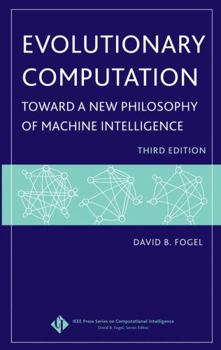Evolutionary Computation: Toward a New Philosophy of Machine Intelligence
This Third Edition provides the latest tools and techniques that enable computers to learn The Third Edition of this internationally acclaimed publication provides the latest theory and techniques for using simulated evolution to achieve machine intelligence. As a leading advocate for evolutionary computation, the author has successfully challenged the traditional notion of artificial intelligence, which essentially programs human knowledge fact by fact, but does not have the capacity to learn or adapt as evolutionary computation does. Readers gain an understanding of the history of evolutionary computation, which provides a foundation for the author's thorough presentation of the latest theories shaping current research. Balancing theory with practice, the author provides readers with the skills they need to apply evolutionary algorithms that can solve many of today's intransigent problems by adapting to new challenges and learning from experience. Several examples are provided that demonstrate how these evolutionary algorithms learn to solve problems. In particular, the author provides a detailed example of how an algorithm is used to evolve strategies for playing chess and checkers. As readers progress through the publication, they gain an increasing appreciation and understanding of the relationship between learning and intelligence. Readers familiar with the previous editions will discover much new and revised material that brings the publication thoroughly up to date with the latest research, including the latest theories and empirical properties of evolutionary computation. The Third Edition also features new knowledge-building aids. Readers will find a host of new and revised examples. New questions at the end of each chapter enable readers to test their knowledge. Intriguing assignments that prepare readers to manage challenges in industry and research have been added to the end of each chapter as well. This is a must-have reference for professionals in computer and electrical engineering; it provides them with the very latest techniques and applications in machine intelligence. With its question sets and assignments, the publication is also recommended as a graduate-level textbook.
Format:Hardcover
Language:English
ISBN:0471669512
ISBN13:9780471669517
Release Date:December 2005
Publisher:Wiley-IEEE Press
Length:296 Pages
Weight:1.15 lbs.
Dimensions:0.7" x 6.9" x 9.4"
Customer Reviews
2 ratings
for researchers and students
Published by Thriftbooks.com User , 18 years ago
Ignore the gushing blurb on the back cover about the book having the latest tools and techniques to let computers learn. While the methods are indeed state of the art when they were written, true learning by computers is still elusive. But so long as you keep that reality in mind, the text can indeed be useful. We see the span of ideas in evolutionary computing. Aided in no small part by the massive and continued increase in computational power. Fogel laments that the book's ideas are still typically outside what is generally taken to be Artificial Intelligence. The book strives to be both a text for researchers and for students. Though of course the two groups overlap. For researchers, each chapter has a long list of references to journal papers and monographs, so that you can go directly to many of the original sources. While for students, the chapters come with a non-trivial set of exercises, that usually involve some programming.
The book provides a solid foundation on the subject.
Published by Thriftbooks.com User , 25 years ago
This is an introductory text useful for teaching at graduate levels in Computer/ Information Sciences. The first two chapters provide an overview of the subject and its relationship with other relevant areas. Chapter 4 covers the analysis of the GA with special emphasis to convergence of the algorithm.This is the main chapter of the book. The presentation style of the book is very beautiful.The book should be read by everyone interested in the disciplines of genetic algorithms and/or soft computing.






